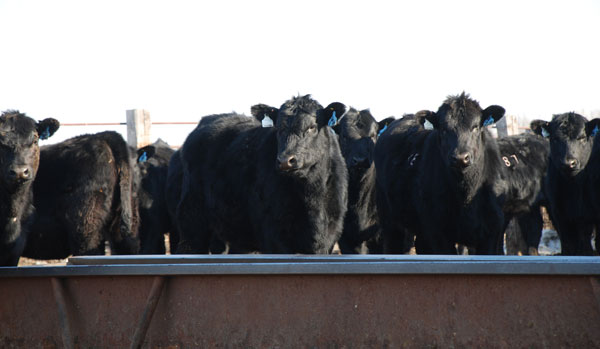November 14, 2013

Yesterday was my 26th birthday, and lucky gal that I am, my husband Tyler bought me a trailer load of bred cows for my big day. I was too tired for dinner and a movie anyway, after spending my birthday tearing down and replacing fence in some old lots we have in order to get them winterized for these spring-calving cows.
While we worked, Tyler was calculating numbers in his head -- how many extra tons of hay we’ll need, how early our first cows will be calving, and how many days we have left to finish up our projects before the snow flies.
As we crunch the numbers and double-check our feed resources to make sure we have enough hay to feed our cows through the winter, there are a few important factors to think about. This includes just how much a gestating cow will eat and the quality of forages we have on hand.
With winter just around the corner, I’m sure most of you are well along in stockpiling your forage resources for the cold months ahead. For those of us still winding up the process, here are a few key considerations to think about, courtesy of Glenn Selk, Oklahoma State University Emeritus Extension animal scientist.
Selk says that estimating forage usage by cows is an important part of the task of calculating winter feed needs. "Hay or standing forage intake must be estimated in order to make the calculations. Forage quality will be a determining factor in the amount of forage consumed. Higher-quality forages contain larger concentrations of important nutrients so animals consuming these forages should be more likely to meet their nutrient needs from the forages. Also cows can consume a larger quantity of higher quality forages," he says.
Selk explains that higher-quality forages ferment more rapidly in the rumen leaving a void that the animal can refill with additional forage. "Consequently, forage intake increases. For example, low-quality forages (below about 6% crude protein) will be consumed at about 1.5% of body weight (on a dry matter basis) per day. Higher-quality grass hays (above 8% crude protein) may be consumed at about 2.0% of body weight. Excellent forages, such as good alfalfa, silages, or green pasture may be consumed at the rate of 2.5% dry matter of body weight per day. The combination of increased nutrient content AND increased forage intake makes high quality forage very valuable to the animal and the producer. With these intake estimates, now producers can calculate the estimated amounts of hay that need to be available.
“Using an example of 1,200-lb. pregnant spring-calving cows, let's assume that the grass hay quality is good and tested 8% crude protein. Cows will voluntarily consume 2.0% of body weight or 24 lbs/day. The 24 lbs. is based on 100% dry matter. Grass hays will often be 7-10% moisture. If we assume that the hay is 92% dry matter or 8% moisture, then the cows will consume about 26 lbs./day on an 'as-fed basis.'
"Unfortunately we also have to consider hay wastage when feeding big round bales. Hay wastage is difficult to estimate, but generally has been found to be from 6% to 20% (or more). For this example, let's assume 15% hay wastage. This means that approximately 30 lbs. of grass hay must be hauled to the pasture for each cow each day that hay is expected to be the primary ingredient in the diet,” Selk says.
In addition to these considerations, we must also consider mineral needs, and determine if the protein available in our alfalfa and mixed grass hay will be enough for these cattle, or if we need to add a supplement program to the mix. Hopefully we’ll have it all figured out by the time the snow flies.
How about you? Do you have enough forage resources on hand, or will you need to purchase more? What’s the cost of hay in your area? Do you supplement with mineral during the winter months? How does your ration change as the cow enters her final months of gestation and after calving? Leave your thoughts and experiences in the comments section below.
You might also like:
Bale Grazing Lets Cows Feed Themselves
Winter Is Coming --> 200 Breathtaking Photos Of Winter On The Ranch
You May Also Like



